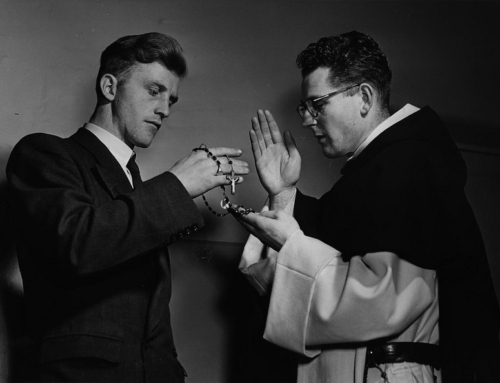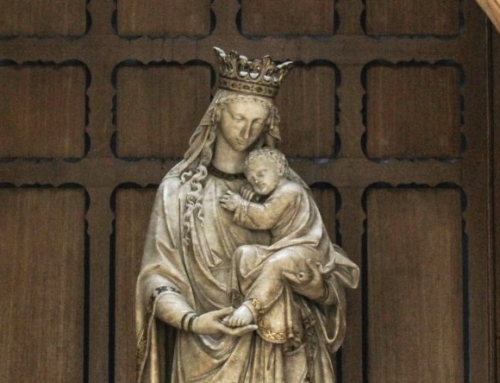Benedict Croell, O.P. and Andrew Hofer, O.P. A Living Sacrifice: Guidance for Men Discerning Religious Life. Valdosta, Georgia: Vianney Vocations, 2019. 277 pp.
A Living Sacrifice fills a void in materials for men discerning religious life. When I was beginning to discover my vocation, I felt that I was called to religious life and the vows of poverty, chastity, and obedience, but the only guides to discernment I could find were for men who were called to be priests, and none of these books spent much time on religious life. The resources were scattered and difficult to navigate unless a man had a skilled vocation director. I was blessed to have the co-authors of this book as my vocation director, Fr. Benedict Croell, and student master, Fr. Andrew Hofer. This book is a distillation of their many years of experience and consolidates many scattered resources, which are referenced in appendix F.
The well-structured format of the book, five sections of three chapters each, easily suggests a variety of possible uses. Of course, the book could be given wholesale to a man who has some confidence that God is calling him to investigate religious life, but many of the chapters could easily stand on their own as the basis for a group discussion among men who are in the process of considering religious life. Some chapters could also be used to begin a discussion of the value of religious life among the laity, encouraging the acceptance of vocations and prayer for their increase.
While the authors point out that one of the most insidious enemies to a religious vocation is too much time in front of screens, that doesn’t mean they fail to reach a generation known for its short attention span. With clickbait-esque titles like those ubiquitously found online—Ten Truths to Set You Free from Discernment Traps (Chapter 1), Ten Things to Do When Considering Religious Life (Chapter 2), and Ten Things Not to Do When Considering Religious Life (Chapter 3)—the first three chapters elaborate helpful ten-point lists that are quick, easy tips to help the reader make sure he is on track. With no more than a few paragraphs per point, a young man can focus on one point at a time to evaluate how serious he is about considering religious life.
The second set of three chapters is meant to motivate and inspire. These chapters put forward why a young man would feel called to be a religious. They propose the heart of religious life: a deepening of the baptismal call to holiness (Chapter 4) lived out by imitating Christ in the three evangelical counsels of poverty, chastity, and obedience (Chapter 5), through the inspiration of the Holy Spirit (Chapter 6). How well these chapters resonate with the reader might be a good first measure of whether God is calling him to religious life.
The third set of three chapters teases out the distinction between religious life and the priesthood. It was once jokingly explained to me that there are two vocations in the Church: marriage, holy orders, and religious life. This tongue in cheek remark conveys the initially puzzling place of religious life in the life of the Church. The authors first try to make clear the distinction between diocesan priests, religious priests, and religious brothers (Chapter 7). After giving these definitions, the differences are illustrated in the history of religious life and the many charisms lived out by different orders throughout the long life of the Church (Chapter 8). Finally, so as to provide a more personal encounter with religious life, the reader is introduced to saints who founded or were outstanding members of various religious orders (Chapter 9).
The fourth set of three chapters helps the reader to take the next concrete step in his journey of discernment. They also give the reader a preview of what he will find should he enter religious life. Chapter 10 gives advice on how to navigate the application process. It covers the paperwork, interviews, and visits that will be required when applying to any religious order, and it also gives general advice on when a young man should start telling family, friends, or bosses that he is applying. Some of the authors’ simple advice can go a long way to make the application process smoother. For instance, they warn the young man that not all bosses will be thrilled to hear that their employee is planning to quit in six months and that he could find himself out of a job a few months earlier than he was expecting. Chapters 11 and 12 then give a very brief overview of the life of formation that is to be expected once he enters, lest it be wholly shrouded in mystery.
The final set of three chapters provides snapshots of life in different religious orders. They make sure that the reader is not only exposed to Dominican religious life but also other orders. Chapter 9 already shared what various saints of religious orders have said concerning religious life in general, but in these chapters we hear what they have to say about their own orders in particular. Hearing from both holy saints of times past as well as men living out the charisms of their orders in today’s world, the reader can seek out an order that attracts him personally. This section on its own provides an excellent introduction to many of the most prominent religious orders of the Church.
This book is an invaluable addition to any parish or campus ministry library. It will certainly be useful for those beginning to discern, but it can be used just as well for discussions or presentations on religious life. Perhaps consider buying the book as a gift for your pastor so he can have it as a resource when young men come to him for advice about religious life. Or you might send one to a young man who is interested in religious life. Still, this book isn’t just for those who are seeking to enter a religious order. Anyone who wants to learn more about religious life would benefit from this book.
Reviewed by Bartholomew Calvano, O.P.
✠
Download a PDF of this article here



